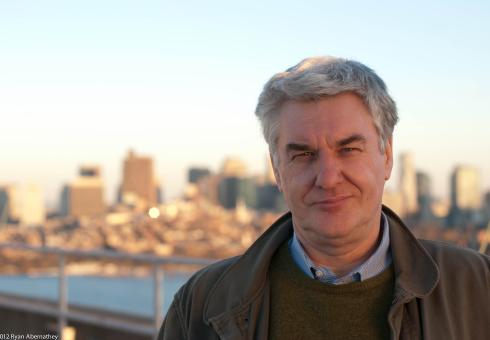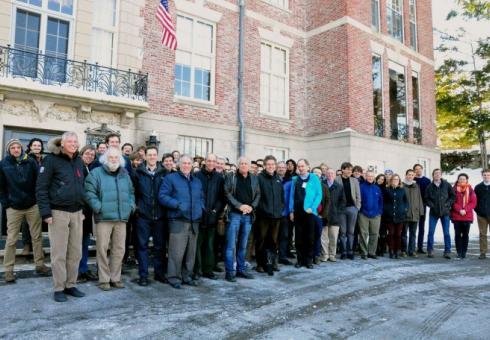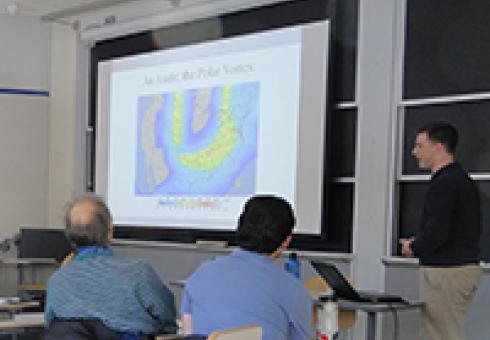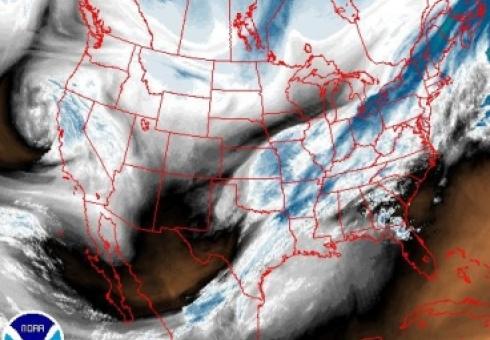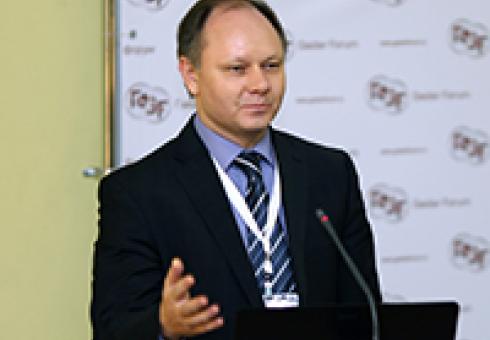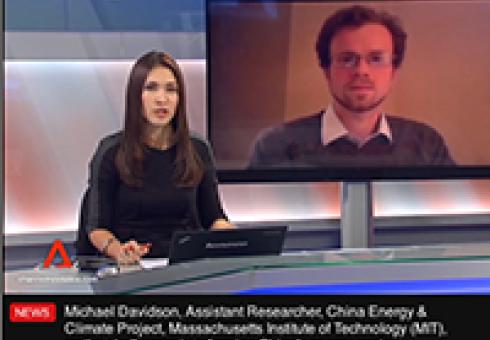CS3 In the News
Genevieve Wanucha
Oceans at MIT
John Marshall, Cecil and Ida Green Professor of Oceanography, recently accepted the 2014 Sverdrup Gold Medal of the American Meteorological Society for his “fundamental insights into water mass transformation and deep convection and their implications for global climate and its variability."
Marshall is an oceanographer with broad interests in climate and the general circulation of the atmosphere and oceans, which he studies through mathematical and numerical models of physical and biogeochemical processes. His research has focused on problems of ocean circulation involving interactions between motions on different scales, using theory, laboratory experiments, and observations as well as innovative approaches to global ocean modeling pioneered by his group at MIT.
The Sverdrup Gold Medal recognizes Marshall’s influential ideas about deep convection in the ocean, the process by which, in certain polar regions, cooling water descends, transporting properties such as oxygen, salt, carbon, and heat into the ocean’s deep interior. Marshall, in a 1990s collaboration with his graduate students Sonya Legg and Helen Hill, née Jones, and the late Professor Friedrich Schott of the University of Kiel, in Germany, demonstrated that the convective process in the ocean occurs slowly enough for it to be influenced by Earth’s rotation. This insight overturned the prevailing view that convection in the ocean was an upside-down version of atmospheric convection.
Marshall’s work on rotating convection in water mass transformation triggered a vast amount of research, including the Labrador Sea Deep Convection Experiment, a major field program in 1996 that provided the most comprehensive set of measurements of ocean convection. The dataset collected on this international expedition led to insights into the convective process in the ocean and its representation in models in light of Marshall’s theoretical descriptions. This body of work also motivated the development of the MIT General Circulation Model (MITgcm), which Marshall’s group first used to simulate deep convection fluid dynamics at high resolution. The algorithms used to represent convection drive the modern-day MITgcm, one of the most widely used global ocean models in the world.
To gain a broader understanding of Earth’s fluid dynamical system, Marshall shifted focus to contemporary issues in global ocean circulation. “I’ve always tried to move forward,” Marshall says. “Even though this work on water mass transformation was enjoyable, I stopped it and moved on to study the role of the Southern Ocean in climate.” Marshall has now spent 10 years revising the scientific understanding of the Antarctic Circumpolar Current (ACC). In particular, his updated modeling shows that the ACC brings up deep water and buried carbon to the surface around Antarctica, leading him and colleagues to suggest that the Southern Ocean is the window by which the interior of the ocean connects to the atmosphere, and is thus a powerful mediator of climate.
Professor Marshall received a PhD in atmospheric sciences from Imperial College London in 1980. He joined MIT’s Department of Earth, Atmospheric and Planetary Sciences in 1991 as an associate professor and has been a professor in the department since 1993. He was elected a Fellow of the Royal Society in 2008. He is coordinator of Oceans at MIT, a new umbrella organization dedicated to all things related to the ocean across the Institute, and director of MIT’s Climate Modeling Initiative (CMI).
Michael Davidson
MIT-Tsinghua China Energy and Climate Project
According to tallies by the National Energy Administration, China added 14 gigawatts (GW) of grid-connected wind power capacity in 2013, now the fifth consecutive year with installs of over 10 GW (here, at a glance, is China’s grid in 2013). Over the same time period, wind curtailment – or, spilled wind, which is when the grid operator tells wind farm operators to reduce output because of reliability or other constraints – has become one of two sore spots, together with grid connection, for the otherwise booming sector (read more background on both topics). Official estimates now available of wind curtailment in 2013 show some improvements over 2012, though the problem is far from solved.
As in previous years, northeastern provinces with large coal-fired power capacities and the transmission-constrained northwestern region topped the list for curtailed wind. Inner Mongolia is part of two separate grid regions: the northwest (W. IMAR) and the northeast (E. IMAR). In the figure, I show the actual capacity factor as well as its reduction compared to the potential capacity factor according to official curtailment statistics.
Measuring curtailment is particularly tricky, because once turbines are slowed or halted it is difficult to reconstruct what the wind power production would have been otherwise. Comparing to the U.S., which consistently has an edge in terms of utilization of its wind turbines, China’s wind farms are under-performing, even after correcting for curtailment. This is largely attributed to different quality in components, though inaccurate curtailment numbers may also play a role. Collectively, this has led to the third year in a row of the unfavorable situation of China leading the world in wind capacity yet still trailing in terms of generation.
Approvals for new wind in some of the provinces heaviest hit by curtailment (Heilongjiang, Jilin, Inner Mongolia and Yunnan) are now being held up as the central government reconsiders how to divvy up its renewable subsidies and promote the sector most efficiently. Following a shake-up by the State Council last March, the central planning agency, the National Development and Reform Commission (NDRC), in theory gave up approval authority to the provinces, after only receiving it two years prior. However, currently, a “makeshift plan” which still incorporates centrally-administered annual targets is being implemented to transition to a more market-based approach.
On the other side of the spectrum, the capacity factor of thermal power (of which coal was 95% of generation in 2012) maintained historically low levels in 2013. Coal’s precipitous decline in the U.S. following the shale gas boom has led to a reduction in capacity factor of 14 percentage points here. Yet, whereas new coal builds in the U.S. are stagnant, China’s decrease has occurred amidst continued capacity expansion.
In these low utilization provinces, there is increasing evidence that China’s coal-fired power sector is overbuilt. In Jilin, for example, a wind-rich northeastern province, coal plants generate at less than 40% of their capacity even as coal capacity doubled from 2008-2011. The Jilin government is expediting approvals for large energy consumers and subsidizing their electricity bills above baseline in an attempt to pick up the slack.
Critically, overcapacity when coupled with China’s generation cost recovery mechanisms and constraining minimum outputs for thermal generators may mean less integration space for renewables—as I explained before here.
The China Electricity Council, in its 2014 projections and recommendations, called out the northeast’s excess capacity problem, recommending that the central government “strictly control” new coal and wind construction in the region. It projected a smaller (though still substantial) increase in coal-fired capacity nationwide of 30 GW. CEC’s other projections for new installs in 2014 (my calculation based on the current 2013 capacity figures): 23 GW hydro, 17 GW wind, 14 GW solar, 6 GW nuclear, and 5 GW gas.
Read the rest of the story here.
By Genevieve Wanucha
Oceans at MIT
Water has a lot of say in how Earth’s climate works. And scientists often acknowledge that the uncertainty about climate’s future trajectory comes from a lack of understanding of water. This intellectual challenge filled the better part of February 10-12 for 37 leading climate researchers and graduate students and postdoctoral fellows who participated in the Lorenz Center’s first scientific workshop, “Water in the Climate System,” at the MIT Endicott House in Dedham, Massachusetts.
The Lorenz Center is a new climate research initiative founded by MIT professors Kerry Emanuel and Daniel Rothman in the Department of Earth, Atmospheric, and Planetary Sciences as a way to renew the emphasis on fundamental questions about climate. The founders dedicated the center to the late MIT professor Edward N. Lorenz, the architect of chaos theory, who shared their conviction that a better description of the underlying principles in climate will make the complex system easier to understand.
Some of the biggest names in climate-related fields presented work on climate and hydrological mechanisms to an audience packed with inquiring minds. Sessions included “Convection,” “Water Vapor, Clouds, and Climate,” “Moisture and Weather,” “Precipitation and Climate,” and “Potpourri,” an eclectic mixture of aquaplanet modeling and geomorphology. All 26 presentations are available in slide format here.
“It was a great opportunity for younger scientists to learn about the big ideas in the field and hear from voices outside of MIT,” says MIT PhD student Tim Cronin. In every discussion period, to avoid the “experts-talking-to-experts” phenomenon, Emanuel asked the graduate students and postdocs to pose the first few questions. This approach made the newer generation of researchers more than mere observers, and their questions drove the conversation, animating the experts in intense discussions of the major climate conundrums of our time: How do ocean and atmosphere circulations transport heat across the globe? How can we design models that accurately estimate regional changes in the water cycle as the globe warms? When can we expect significantly different summers and snowstorms?
This workshop was made possible by a generous gift from Colin Masson, a retired astrophysicist who appreciates the Lorenz Center’s broad view of climate science and who attended the event. Private donations like Masson’s support the Lorenz Center’s regular activities, which also include the annual John Carlson Lecture. To reach their ultimate vision, Emanuel and Rothman are currently raising funds to support graduate students, postdoctoral researchers, and visiting scientists with backgrounds in diverse areas such as applied mathematics, biology, and chemistry.
“Our idea, simply put, is both to attract the very best minds to climate science and to give them free rein to think creatively, unsaddled by the pressing practical demands of climate forecasting,” the founders write in "A Fresh Approach to Climate Science" (pdf). If the “Water in the Climate System” workshop was any indication, the Lorenz Center is already a magnet of basic research talent.
In climate change, science and policy are inextricably linked—more so than in most contemporary social phenomena. The complexity of understanding earth’s systems generates uncertainty, which feeds into an imperfect policy process that often warps ideal economic instruments beyond recognition. Without clear recognition of this linkage, the resulting mixture is frequently less than appetizing. This January, we continued an MIT Joint Program on the Science and Policy of Global Change tradition of presenting to the MIT community the basics (and some of the nuance) of this complex issue over a two-session Independent Activities Period (IAP) course.
While the minutiae of a 3-dimensional atmosphere and ocean model may be daunting (and require clusters of networked high-performance computers to complete a run), it turns out we can understand a lot about climate change from simplified models that build on basic physics accessible to any first-year undergraduate. Fundamental principles, such as energy balance, yield straightforward arguments about why the Earth should warm as we add greenhouse gases to its atmosphere. Those same principles can also be used to frame simple predictions about how future warming might proceed—information that policymakers and analysts can use to help plan for the future.
Considering climate change as an “externality” (a cost imposed on society by individuals and companies without compensation), economists have developed theories of how to reduce environmental impacts by appealing to pocketbooks. Putting a price on pollution (e.g., carbon tax) or selling and trading “rights” to pollute (e.g., cap-and-trade) are two common policy levers to encourage polluters to cut back while lessening the overall economic impact. When we couple our global climate models with global economic models (collectively, the Integrated Global System Modeling framework – IGSM), we can better understand the complex interactions between human activities and earth system changes.
We are invariably asked: Do we prefer to tax or to trade? Strictly economically speaking, if we have perfect information on the damages from climate change and the costs required to mitigate, the two should be equivalent. However, accounting for uncertainties on both ends of the human-earth interaction, we find that our answer from a strictly modeling perspective depends on which we can estimate better: the social cost of carbon (the total cost to society of the externality) or the “tipping point” thresholds of irreversible climate change? This is an area of ongoing research.
Policy-makers tend to respond to what they can see, an important part of the policy-science nexus of climate change. Typhoon Haiyan, which devastated the Philippines last November, stood as a stark reminder of the human suffering from extreme weather events—as did Hurricanes Sandy and Katrina on the domestic front. Hitting land just as the annual UN climate talks opened in Poland, Haiyan (or Yolanda, in the Philippines) became an impetus for international efforts there to create the beginnings of a “Warsaw Mechanism”, an international compensation scheme for loss and damage resulting from climate change. Predicting how the frequency and severity of such storms will change in a warming world is a crucial research focus, particularly as society builds more densely along coasts and in floodplains and exposes itself to more potential economic and personal loss.
Ultimately—unlike the Earth’s orbit—no policy issue exists in a vacuum. As we described examples of current efforts in the US, China and the EU to reduce greenhouse gas emissions, it is rare that the best of both science and economics are captured by policies in practice. The prevailing politics have a large impact on where the needle lands—tax, trade or other—and indicate an even bigger challenge that lay before us, not as scientists but as citizens.
Daniel Rothenberg and Daniel Gilford are graduate students in MIT’s Department of Earth and Planetary Sciences. Michael Davidson and Arthur Yip are graduate students in MIT’s Engineering Systems Division.
Genevieve Wanucha
Program in Atmospheres, Oceans and Climate
IAP 2014 was bone-chilling, and thanks to 12.310, An Introduction to Weather Forecasting, 20 new amateur forecasters can tell you why.
Always offered between semesters, 12.310 reveals the principles of fluid dynamics that govern the atmosphere’s movement. In lectures, real forecasting exercises, and a trip to WBZ TV’s on-air weather center, students learn where newsrooms get their daily weather predictions — and how they can make their own.
“Our aim is that students come to understand that weather forecasting is not guessing and is based on real science,” says Lodovica Illari, senior lecturer in synoptic meteorology in MIT’s Program for Atmospheres, Oceans, and Climate (PAOC), who has taught the course for 20 years. “We hope the students get interested in fluid dynamics and come back and do some more.”
To reveal the laws governing the atmosphere’s motion “in action,” Illari used demonstrations with MIT’s Weather in the Tank materials. In one class, Illari rotated a cylindrical tank of water on a turntable to emulate the dynamics of Earth’s atmosphere. A bucket of ice at the tank’s center created a temperature gradient. As students peered in, Illari dropped ink into the water to make visible the small currents forming in the water, demonstrating the conditions that create weather systems.
12.310 stands as a yearly reminder of MIT’s distinguished history in weather forecasting. In fact, Carl-Gustaf Rossby, who transformed weather forecasting into an atmospheric science, founded the country’s first meteorology program at MIT in 1928. A line of prominent MIT faculty meteorologists followed, including Jule Charney, Norman Phillips, Victor Starr, and Edward Lorenz. The fundamental contributions to fluid dynamics made by these past professors resonate in MIT’s modern-day research into much longer-time-scale atmospheric phenomena such as climate.
As the students of 12.310 learned the basics of weather forecasting, they came to appreciate an insight of Professor Lorenz’s that changed meteorology forever. At MIT in 1961, Lorenz found that rounding a few digits off one decimal number in a computer weather simulation changed its projected long-term pattern. He had discovered the big implications of the chaos theory principle of “sensitive dependence on initial conditions” for weather prediction. Slightly imprecise measurements, even single-digit differences in dew point, can skew long-term forecasts. The chaotic nature of short-term weather places a limit of less than 10 days on accurate forecasts.
To make their own forecasts, the students used raw data spit out of weather prediction models run at the National Weather Service, which are read out in maps of the temperature, air pressure, dew point, wind, and moisture across the country. With that information, the students anticipated the likely passage of warm or cold weather fronts by searching for regions of strong gradients in temperature or moisture and shifts in wind direction. The class ended with a TV-style presentation of the day’s weather and a Boston weather forecasting competition. This year, Fiona Paine ’17 took home the prize of a digital indoor/outdoor thermometer.
The course was organized and taught by Illari and co-instructor Jeff Scott, a research scientist at PAOC and the Center for Global Change Science, along with teaching assistants Casey Hilgenbrink ’15 and PAOC graduate student Vince Agard ’11, who are both members of the MIT Weather Forecasting Team.
Many of the undergraduates signed up for 12.310 to get a taste of the kind of science they could pursue in PAOC. Others said that knowing how to predict the weather is just plain useful. And everyone found the class eye-opening. “It was surprising to me just how difficult it can be to predict tomorrow's weather, even when using the newest technology,” says Oren Katzen ’16. “I will be certain to be more forgiving to the weatherman in the future.”
By Michael Davidson
It is quite a challenge to pin down an electricity system that has grown 10.8 percent annually over the last decade, doubled power generation in just 7 years and added 80-90 gigawatts (GW) – the equivalent of the United Kingdom’s entire generating capacity –every year.
Nevertheless, some preliminary year-end statistics recently published by central agencies (NEA, NBS,CNREC) offer an interesting, though imperfect, snapshot of China’s power sector in 2013.
Notably, after a lull in 2012, electricity demand growth recovered last year owing to resurgent industrial demand. Coal retained its share in terms of capacity factor, while wind saw a rise in capacity factors indicating that some measures to improvement integration have had an impact. The “Big Five” state-owned generating companies – which collectively own 47 percent of Chinese generating capacity – made record profits in 2013, and the top electricity regulator was rolled into the top energy policy body in an attempt to streamline oversight.
Let’s take a spin through the 1,250 GW Chinese electricity system…
Electricity demand rebounds with heavy industry-led growth
In 2012, electricity demand growth fell to 5.6 percent, its lowest rate since 1998. In contrast, 2013 saw electricity growth regain 1.6 percentage points, to 7.2 percent growth for the year. While GDP grew at the same 7.7-7.8 percent rate in both years, last year’s surge in electricity demand was driven by anuptick in heavy industry-led growth. Crude steel production grew 7.5 percent compared to 3.1 percent in 2012, while the automobile production sector grew 18.4 percent, almost three times faster than in 2012. As over 70 percent of electricity production in China goes to satisfy industry demands, this readjustment drove national power sector demand (see figure, throughout, historic data is from the CEC– China Electricity Council.) More...
The Global Young Academy (GYA) is an international group of two hundred young (up to ten years post PhD) scientists selected based on research excellence and commitment to impact. Through GYA, members are linked to the senior international academy network IAP, meet outstanding leaders of the international science community and may be nominated to contribute to international policy statements and working groups. Appointments are for a period of four years.
Selin's research focuses on using atmospheric chemistry modeling to inform decision-â€making strategies on air pollution, climate change and toxic substances including mercury and persistent organic pollutants. She has also published articles and book chapters on the interactions between science and policy in international environmental negotiations, in particular focusing on global efforts to regulate hazardous chemicals and persistent organic pollutants.
Selin, who will be formally appointed at a GYA symposium on May 21st, says she is very much looking forward to leveraging her new appointment to expand the reach of her science-policy work and educational initiatives.
By Michael Craig, Amanda Giang, Colin Thackray 

What’s the difference between climate change, the Northern spotted owl, and acid rain?
That question is not the beginning of a bad joke. Rather, it was the type of question that lay at the heart of the class ‘Science, Politics, and Environmental Policy’ offered this past fall at the Massachusetts Institute of Technology. For the first time, the class was co-taught by Professors Susan Solomon of Earth, Atmospheric and Planetary Sciences and Judy Layzer of Urban Studies and Planning – an interdisciplinary team that drew students from diverse backgrounds across MIT’s schools and departments. Through weekly case studies, the class aimed to better understand how the United States has dealt with environmental problems and the multifaceted role of science in that process.
Each week, students focused on a different environmental issue, ranging from historical examples like the use of lead in gasoline, to currently unfolding debates, like the environmental impacts of unconventional shale gas production. Through reading, writing, and discussion, students explored how and why these issues entered the policy agenda (or didn’t), evolving policy responses, and how science fit into the picture. While fast and hard conclusions were elusive, as the class drew to a close students reflected on several themes that emerged over the course of the semester: the complexity of the policy-making process, the convoluted path that science takes from its origin to its use in policy, and the importance of storytelling for communicating science effectively.
Opening the black box of policy-making
Many of us initially saw the policy process as a black box – we could see the inputs (mainly science) and outputs (environmental policy), but did not fully grasp how one led to the other. Over the course of the semester, we came to a far better understanding of what levers exist to influence the policy-making process.
Some of those levers are litigation, direct involvement in the political process, and communication to the public. Each can influence the conversion of inputs to outputs, but vary in effectiveness under different circumstances. In part, such circumstances emerge from existing economic and political institutions, which can constrain policymaking and create path dependency. Recognizing these realities through case studies demonstrated the importance of looking at policy issues from different angles and thinking carefully about the best strategy for effecting change.
The path from science to policy
As we peeled the lid off the black box of policymaking, we also began to recognize how convoluted the path science travels from generation to use in policymaking can be. Science does not pass directly from academics to policymakers, but rather is filtered and translated by many individuals. These individuals – and even scientists themselves – have differing values, biases, and goals that can lead them to different interpretations of, and conclusions from, science. What role, if any, should scientists play along science’s path from lab to policy? Do scientists who act as advocates harm the credibility of science as a whole, and if so, does this harm outweigh the potential benefits? For scientists who act as the ‘experts’ that communicate the scientific basis of environmental issues to non-scientists, how do their biases and values shape their actions and their interpretation of science? If science is being filtered and reinterpreted, how can we ensure the veracity of information we receive that is purportedly "based on science”?
Stories matter
Over the course of the semester, the importance of storytelling also emerged as a major theme. In many of the cases we studied, public engagement was a key driver for policy action, so effectively communicating with and reaching the public is crucial. Doing so requires the ability to tell a clear story – to communicate information (scientific or otherwise) clearly, concisely, and in a way that is relevant to the audience. Focusing on what you know can help in putting forth a clear narrative, and while uncertainties are important to convey, they do not need to be the focus of communication.
There is no easy formula for developing strong environmental policies, nor are there simple rules for how science should be involved. That said, 'Science, Politics, and Environmental Policy' helped us develop a more nuanced understanding of the complex policy-making process, and gave us tools to engage in it strategically, and with self-awareness. Rarely is there an opportunity to discuss the many-layered environmental policy system with students with such diverse expertise. The confluence of ideas and points of view from the varied backgrounds of both the students and professors resulted in a unique learning experience for this collection of young environmental scholars.
Colin Thackray is a graduate student in MIT's Department of Earth, Atmospheric and Planetary Sciences working with Noelle Selin. Amanda Giang and Michael Craig are graduate students in MIT's Engineering Systems Division.
Sergey Paltsev, assistant director for economic research at the MIT Joint Program on the Science and Policy of Global Change, presented at the 2014 Gaidar Forum entitled "Russia and the World: Sustainable Development."
The expert discussion “Green growth” and sustainable development” was dedicated to such topics as energy efficiency and renewable energy as the drivers of economic growthas economic growth drivers. Besides it focused on the perspectives of “the third industrial revolution”, which is not a new idea, however it opens the prospects for efficient energy use.
Oleg Lugovoy, Research Advisor, Center for Economic Modeling of Energy and Environment, RANEPA, Jeffrey Sachs, Director of the Earth Institute and Professor of Columbia University, Hillard Huntington, Executive Director of Energy Modeling Forum, Stanford University, Emmanuel Guérin, Associate Director of Sustainable Development Solutions Network (SDSN), Frederic Vidal, President of Université de Nice Sophia-Antipolis, Sergey Paltsev, Assistant Director for Economic Research of MIT Joint Program on the Science and Policy of Global Change of the Massachusetts Institute of Technology, John Laitner, Resource Economist and Independent Consultant of Economic and Human Dimensions Research Associates and Glen Peters, Senior Research Fellow of the Center for International Climate and Environmental Research of Norway, took part in the discussion.
In his opening remarks, the moderator Oleg Lugovoy defined the vector of the discussion: “It’s a discussion on how to achieve high growth rates and improve life quality without causing harm to the environment.” He also noted that the problem could not be solved by the efforts of business and public organizations alone, but depends on economic regulation.
John Laitner turned the participants’ attention to the task of increasing the quality of energy efficiency giving USA as an example, where 86% of all energy is spent to no purpose. Inefficient use of energy leads to huge costs and is a factor limiting, in Russia as well, the potential for economic development. The expert underlined that the idea of the third industrial revolution which consists of combination of interactive communications and new green technologies is getting more important.
Jeffrey Sachs reminded the participants of the discussion about the idea of a prominent Russian economist Nikolai Kondratyev on periodic economic cycles (waves) linking it to the concept of a shift in technological modes. Each of them had limited resources, but never before has the scale of economic activity been so impressive and the number of population so huge (7.2 billion people). “90 trillion dollars – this is the volume of the annual economic output,” Jeffrey Sachs noted, “and this figure tends to grow progressively. So do the CO2 emissions as well. Already today 38 billion tons of СО2 are annually emitted into the Earth’s atmosphere,” the expert noted.
However, changing the energy system profoundly and substantially over 40-50 years is quite a challenge. One of the possible solutions is to switch to alternative types of fuel or renewable energy sources. Nuclear energy, if it is safe, also has a high potential. But the most important thing, according to the expert, is to reduce coal consumption, in particular, “convince China, the country which consumes this fuel in huge volumes, to do so.”
The report by Hillard Huntington marked a turn in the discussion to the subject of shale gas. The expert noted numerous uncertainties pertaining to shale gas extraction. It is still difficult to evaluate the outlook for price policy in this field unambiguously, which is caused not only by the way it is extracted, but also the volumes of gas supply.
Sergey Paltsev agreed with his colleague. He immediately dotted the i’s noting the “platitude” of shale gas: “It does not differ from the common methane, the difference lies in the method of extraction which consists in subsurface fracture.” Answering the question “whether Gazprom has overslept shale gas revolution or not”, the expert agreed with the estimation given by the Prime Minister of the Russian Federation Dmitry Medvedev who said that “this question is quite complicated.” “Gazprom has enough gas and it can go without shale gas, given proper investment and price policy,” Mr. Paltsev summarized. He also noted that the consequences of fraction are difficult to predict. Besides, the use of huge amount of water during extraction makes its benefits ambiguous, at the same time CO2 emissions from the use of natural gas are far from zero, therefore it is impossible to say that its production can address the problem of emissions globally.
Channel News Asia interviews Michael Davidson on the Business Central show. Michael Davidson is Research Assistant for the China Energy and Climate Project and a doctoral student in the Engineering Systems Division.
In many public discussions of climate change, science takes a back seat to political agendas and rhetoric. But 12.340x (Global Warming Science), a new massive open online course from MITx now open for enrollment on the edX platform, aims to change that dynamic by providing a solid scientific view of what is really happening with global warming.
“We are trying to bring back some of the intellectual excitement that belongs to the field,” says Professor Kerry Emanuel, a co-teacher of the course whose research focuses on hurricanes. “This is a serious science course.”
The MITx course will use many of the lecture materials developed for the on-campus version of the course, along with new videos and visuals. The course will also include new exercises, problem sets, and a final exam, all tailored to the assessment tools available on the edX platform and developed with an eye on preserving the rigor of the course. “You have to have a background in mathematics up through differential equations, and a background in physics,” says Emanuel, the Cecil and Ida Green Professor of Atmospheric Science. “Our intent is that it will be as challenging as the classroom course.”
12.340x will also bring simulations used in the MIT residential course to a wider audience, including the single-column model simulation. Emanuel describes this unique tool as “a computer climate model that takes inputs such as solar radiation and atmospheric greenhouse gas content and calculates the temperatures of the surface and atmosphere, and the moisture and cloud distributions in the atmosphere. Students can change the intensity of sunlight, the time of year, the greenhouse gas concentrations, and other inputs to see how they affect climate change.”
Emanuel expects a wide range of people to take 12.340x. “You’re going to find a lot of students in climate and energy. They will want to know the physics, chemistry, and biology (of climate change).” He also expects professionals working in energy and public policy to be interested in the course. Even a politician has expressed interest in 12.340x, but Emanuel is keeping the individual’s name confidential.
Emanuel and the Department of Earth, Atmospheric and Planetary Sciences also hope to change the dynamic around the study of climate change on the MIT campus. In part because the course is not a requirement, and in part because of the perception among students that climate-change study is mostly about politics and not hard science, the on-campus course has not seen the enrollment levels Emanuel would like to see. “Part of the problem is all the publicity of global warming has sent out a message that global warming is highly politicized, and has nothing to do with science,” he says. “Nothing could be further from the truth.”
By Laura Barron-Lopez
Global warming may be contributing to the "polar vortex" causing frigid temperatures across most of the nation on Monday, according to some climate change researchers.
While it seems counter-intuitive, the research argues that plunging temperatures could come from changes in the jet stream caused by climate change.
Rutgers University climate scientist Jennifer A Francis has released a number of papers about changes in the jet stream brought about by warming Arctic temperatures.
Her conclusions suggest that warming Arctic air caused by greenhouse gas emissions has caused changing to the jet stream that is pushing colder Arctic air further south, causing temperatures to plunge from the High Plains to the Deep South.
The jet stream shift has sent frigid air across the central part of the country, and deeper into the south than normal.
Alaska, meanwhile, is being hit by unusually warm conditions and California is facing record-breaking drought, Francis said.
She said the strange weather is becoming more likely because of climate change.
"We can't say that these are extremes are because of climate change but we can say that this kind of pattern is becoming more likely because of climate change," Francis said.
NASA analysis has also drawn a link between the jet stream, climate change and colder temperatures.
A 2010 NASA analysis tied colder temperatures over the course of 2009 to an event similar to the wavy jet stream, called "Arctic oscillation" — a see-sawing pressure system over the North Pole. That oscillation pushed cold air to teh south.
The NASA analysis also said that despite cold snaps, and other weather changes being a part of naturally occurring patterns, they are still in line with a "globally warming world."
According to Francis, big fluctuations in the jet stream cause extreme weather conditions to hang around longer.
She argues greenhouse gas emissions are a key factor.
"The process of warming the Arctic is intensified due to greenhouse gas emissions," Francis said. "The Arctic is warming two to three times faster than the rest of the Northern Hemisphere."
MIT atmospheric scientist Kerry Emanuel said long-term climate change can only be seen by looking at detailed statistics.
“It's certainly plausible, at lease for awhile that a changing jet stream, may cause colder winters,” Emanuel said.
But he added that it is difficult to tie a direct link between individual events like the cold snap occurring in the Midwest and East Coast to global warming.
Emanuel added that that doesn't mean you can disregard global warming.
“If you cherry pick you can always find an excuse to go against [global warming,” Emanuel said.
Image Credit: Satellite Image Shows Entry of the Polar Vortex into the Northern U.S.

